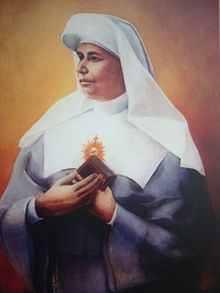Patronage Mariavitism | Name Feliksa Kozlowska | |
 | ||
Birth name Feliksa Magdalena Kozlowska Born May 27, 1862
Wieliczna, Congress Poland ( 1862-05-27 ) Died August 23, 1921(1921-08-23) (aged 59)
Plock, Second Polish Republic Buried Temple of Mercy and Charity, Plock, Poland
52°32′53″N 19°40′48″E / 52.548°N 19.680°E / 52.548; 19.680 Venerated in Catholic Mariavite Church
Old Catholic Mariavite Church Title as Saint Mateczka (Little Mother) | ||
Feliksa Magdalena Kozłowska (27 May 1862 – 23 August 1921), known by the religious name Maria Franciszka and the epithet Mateczka, was a Polish Christian mystic and visionary who founded what eventually became the Old Catholic Mariavite Church and the Catholic Mariavite Church, a faction that was excluded from it in 1935. Both denominations are a schism from the Catholic Church and declared heretical by the Catholic Church.
Contents
Early life

Kozłowska was born 27 May 1862 in Wieliczna near Wegrow. She was eight months old when her father died and was raised by her mother. They lived with relatives first in Pulaski in Czerwonka węgrowski , and later in Baczkach. She graduated from a high school in Warsaw. She planned to join the convent of the Visitation in Warsaw , but as a result of the tsarist regulations with respect to the orders, it proved impossible. After a retreat in 1883 she entered the Congregation of the Franciscan Suffering founded by Honorat Kozminski. Its purpose was to care for the sick.
In 1887 she and five other women entered into communal living in the town of Plock. They followed a Franciscan spirituality. They supported themselves doing embroidery, and followed a relatively strict regimen, abstaining from all meat and fish.
Beginning in 1893, Kozłowska claimed that she experienced religious visions. The first vision allegedly instructed her to form a new clerical order with the primary goal of propagating the Adoration of the Holy Sacrament and devotion to the Mother of God of the Eternal Help. They became known as "Mariavites", as they allegedly took their inspiration for this effort at greater sanctity from imitation of the life of Mary. This group continued for ten years, and in 1903, it attempted to gain canonical status within the Catholic Church. Father Jan Maria Michał Kowalski led this effort. Kozłowska, not wishing to break with the Vatican or to seem in any way to foster heresy, largely stayed out of public view and left the political implications of the movement to others, particularly to Kowalski.
Rejection
In an effort to gain canonical status within the Catholic Church for Mariavitism, the group submitted documentation to its local Bishop of Płock (in whose diocese Kozłowska lived) to the Vatican. Kowalski led a delegation of Mariavites to the Holy See in 1904 and met with Pope Pius X. Kowalski seems to have been promised a high likelihood of success in his quest. He and his fellow Mariavites then experienced deep disappointment when, in August 1904, the Congregation of the Roman and Universal Inquisition (CRUI) Kozłowska's alleged visions were denounced as mere hallucinations.
In April 1906, Pius X issued the encyclical Tribus circiter, which criticised Kozłowska, and her followers also received harsh criticism in it for treating Kozłowska as a living saint and as the equal to the Blessed Virgin. In December 1906, the CRUI excommunicated Kozłowska and Kowalski by name as well as their adherents and supporters. This marked the first instance in history that a woman was excommunicated by name as a heretic as opposed to being excommunicated by virtue of membership in a group deemed to be heretical.
Independence
In November 1906, only a month prior to excommunication from the Catholic Church, the Russian Empire granted the group official toleration in the part of Poland under its control. Cynical motives played a part: a split in the Polish Catholic Church, the tsarist officials realized, could help foster a split in manifest Polish nationalism as well. In 1909, the Mariavites contacted with the Union of Utrecht of the Old Catholic Churches to gain apostolic succession. In 1912, they gained full recognition as a legal denomination in the Russian portion of Poland. They had previously begun work on their own cathedral in Płock, the Temple of Mercy and Charity. They apparently had as many as 50,000 to 60,000 adherents in sixteen parishes and grew greatly during World War I, with the movement having perhaps as many as 160,000 adherents around the time of its peak in 1917.
In 1918, Kozłowska revealed the contents of her final vision. The denomination officially adopted the name Old Catholic Mariavite Church in 1919, two years prior to Kozłowska's death.
After World War I ended and the Second Polish Republic established, the denomination suffered open persecution, and its membership declined, with many adherents reverting to Catholicism. This trend accelerated in 1921 after Kozłowska died and Kowalski succeeded her as the denomination's leader.
Aftermath
Kowalski published a biography of Kozłowska with a compilation of her visions and tried very much to keep her alive in the minds of followers and to make her authority over her followers his own. The hagiographic nature of this work and elevation of Kozłowska to a status seeming co-equal with that of the Blessed Virgin Mary (if not the Holy Spirit) seemed excessive even to many Mariavites, which helped the weakening and, eventually, the split of the movement. Many of the factual details surrounding the life of Kozłowska remain shrouded in myths and legends, some perpetuated by Kowalski.
